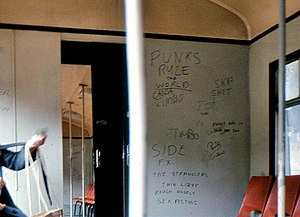This article needs additional citations for verification. (July 2024) |
It has been suggested that this article be merged with GNRI AEC Class. (Discuss) Proposed since July 2024. |
| UTA AEC Class | |
|---|---|
 An AEC Railcar at Lambeg in service with NIR | |
 Interior of a push–pull vehicle at Drogheda in June 1980 with plastic chairs and graffiti | |
| In service | 1951–1972 |
| Manufacturer | GNR Works, Dundalk |
| Replaced | Steam locomotives and carriages |
| Constructed | 1951 |
| Scrapped | 1972 |
| Number built | 20 Power Cars (10 After 1958) |
| Number scrapped | All |
| Formation | 2–8 cars (maximum 4 power cars) |
| Capacity | 44–91 seats per power car, depending on arrangement |
| Operators | Ulster Transport Authority Northern Ireland Railways |
| Specifications | |
| Car body construction | Steel on timber framing |
| Car length | 62 feet 6 inches (19.05 m) |
| Width | 9 feet 6 inches (2.90 m) |
| Height | 12 feet 6 inches (3.81 m) |
| Maximum speed | 120 km/h (75 mph) |
| Weight | 38.5 long tons (39.1 t) (single power car) |
| Prime mover(s) | Two AEC A215 in each power car |
| Power output | 250 brake horsepower (190 kW) per power car |
| Transmission | Mechanical; five-speed preselector gearbox |
| HVAC | Steam heating |
| UIC classification | 1A′A1′ |
| Braking system(s) | Vacuum |
| Coupling system | Screw |
| Track gauge | 1,600 mm (5 ft 3 in) See Rail gauge in Ireland |
Following the end of World War II, most railways throughout the world were looking to either update their fleet of steam locomotives with new and more economical designs or look towards alternatives, which for many meant a programme of dieselisation. The main considerations were the rising cost of coal against diesel oil and the weight of the trains causing wear and tear on the track. In looking to the dieselisation of their system the Ulster Transport Authority (UTA) made early inroads with small, lightweight diesel units, based on those built for the Great Western Railway in England, using the same manufacturers to supply parts and undertaking construction in their own workshops.